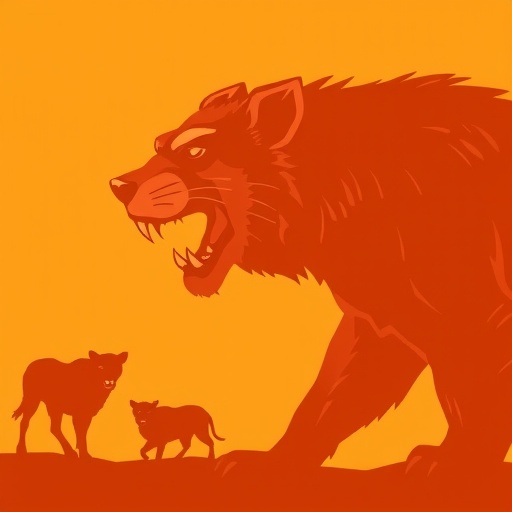In the realm of wildlife conservation, the rising conflict between human populations and large carnivores poses significant ecological and socio-economic challenges. A new groundbreaking study titled “Community-based approach to detect and predict conflicts with large carnivores in human-dominated landscape,” spearheaded by Fedyń, Pasiniewicz, Zabiega, and collaborators, offers innovative solutions to mitigate these tensions, ensuring a harmonious coexistence between humans and these majestic creatures. This research, set to be published in Ambio in 2025, sheds light on the critical need for a proactive, community-driven approach to managing interactions between humans and large carnivores.
As urbanization and industrialization continue to encroach upon natural habitats, the likelihood of human-wildlife conflicts escalates. Large carnivores, including species such as wolves, bears, and cougars, find their territories under siege, leading to increased incidents of livestock predation, property damage, and sometimes even threats to human life. This scenario necessitates a comprehensive strategy that not only identifies potential conflict zones but also involves local communities in the resolution process. The researchers argue that engaging communities in the conservation dialogue can significantly enhance the understanding of large carnivore behaviors and promote sustainable practices.
The core of the research methodology employed by the team revolves around a community-based participatory approach. This approach emphasizes the inclusion of local residents in data collection and conflict prediction efforts. By harnessing the knowledge and experiences of those who live closest to wildlife habitats, the researchers argue that the accuracy of conflict prediction can be greatly enhanced. Community members often have invaluable insights into animal movement patterns and the environmental factors that influence these behaviors, which can be instrumental in shaping conflict mitigation strategies.
Utilizing advanced technology such as GPS collars and motion-sensing cameras, the study incorporates quantitative data that complements local knowledge. These technologies provide critical information regarding the habitat use and travel corridors of large carnivores, painting a clearer picture of their interactions with human-dominated landscapes. By merging scientific data with on-the-ground community observations, the researchers develop a more robust framework for predicting potential conflict scenarios.
Moreover, the study details various intervention strategies that communities can adopt to minimize encounters with large carnivores. These include implementing protective measures for livestock, utilizing deterrents such as guard dogs or noise-making devices, and creating awareness programs that educate residents about safe practices when encountering these animals. By fostering a culture of coexistence and respect for wildlife, communities can lessen their vulnerability while simultaneously promoting the conservation of large carnivores.
An integral aspect of the study emphasizes the importance of building trust between researchers, wildlife managers, and local communities. Effective communication and collaboration are paramount in this initiative. The researchers advocate for consistent engagement with community stakeholders throughout the research process, ensuring that their voices are heard and their perspectives are valued. This participatory model not only strengthens community buy-in but also galvanizes collective action toward wildlife conservation.
The findings of this research are anticipated to have far-reaching implications. By providing a scalable and adaptable model for conflict prediction and management, this study could serve as a blueprint for various regions grappling with similar wildlife-human interaction challenges. The frameworks established could be tailored to fit specific environmental contexts, cultural norms, and community structures, thereby enhancing their effectiveness.
The researchers also highlight the role of policy in addressing human-carnivore conflicts. With the implementation of evidence-based strategies derived from community insights and scientific analyses, policymakers can foster an environment conducive to coexistence. Looking ahead, the study makes recommendations for integrating conflict management strategies into broader land use planning and conservation efforts to ensure that both humans and wildlife can thrive in shared landscapes.
In a world grappling with rapid environmental change, the urgent need to harmonize human activities with ecological preservation could not be more pressing. Large carnivores play a critical role in maintaining ecosystem balance as apex predators, and safeguarding their habitats is not just a matter of conservation but also a necessity for the health of our planet. The research presented in this study underscores the intricate interplay between human development and wildlife conservation, urging stakeholders to work collaboratively toward sustainable solutions.
As the research awaits its publication, the initial responses from fellow conservationists and community leaders have been overwhelmingly positive. There is a palpable enthusiasm around the potential influence of this study, with many anticipating that it will spark a more significant dialogue about human-wildlife coexistence. The spirit of collaboration and innovation that permeates this research is emblematic of the transformative potential inherent in community-based conservation efforts, where wisdom from local populations can meet scientific rigor for a better future.
In conclusion, Fedyń et al.’s imperative research demonstrates that large carnivore conflicts need not be an inevitable consequence of human encroachment onto wildlife territories. Instead, through community engagement and innovative technological applications, there exists an opportunity to recalibrate the relationship between humans and wildlife. The path forward lies in mutual respect, understanding, and a commitment to cohabitating this planet, where both large carnivores and human populations can flourish side by side. With further developments in this exciting research area, the hope is to see tangible changes in both policy and practice that effectively safeguard our natural heritage.
Subject of Research: Human-wildlife conflicts involving large carnivores in human-dominated landscapes.
Article Title: Community-based approach to detect and predict conflicts with large carnivores in human-dominated landscape.
Article References:
Fedyń, I., Pasiniewicz, M., Zabiega, K. et al. Community-based approach to detect and predict conflicts with large carnivores in human-dominated landscape.
Ambio (2025). https://doi.org/10.1007/s13280-025-02241-6
Image Credits: AI Generated
DOI:
Keywords: Human-wildlife conflict, large carnivores, community engagement, conservation, technological approaches, ecosystem preservation.




